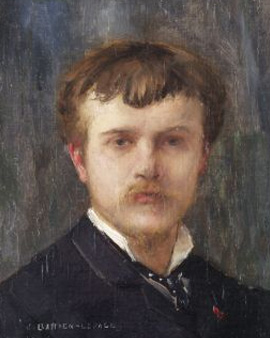Jules Bastien-Lepage was born into the rural life of a large farming family in Lorraine. Working daily in and with nature before his eyes, Lepage devoted himself to depicting landscape motifs after studying at the École des Beaux-Arts in Paris.
Lepage developed an impressionistically influenced style painted with brightened palettes and light reflections in his realistic depictions. The surfaces show an academic accuracy and subtlety. Following his model Millet, Lepage painted his work "Hay Harvest", a painting that was trend-setting for outdoor painting. This was followed by works on the daily work of peasants. The painting "Brushwood Collector" focuses on the landscape and the people.
Br/>
Drawn into the war events around his homeland Lorraine, a change of direction in Lepage's work took place. Back from the war, Jules exhibited in the Paris Salon. Marked by the upheavals in the country, Jules set a sign of veneration with "Joan of Arc". While many artists of his time exhibited sculptures of Joan of Arc, Lepage painted Joan of Arc in the garden of her parents' house. The artist received much criticism for the depiction of an apparition. The spiritual figure was not suitable for a naturalistic painter. In his last years Jules devoted himself increasingly to portrait painting and travelled until he died of cancer at the age of 36.
×





.jpg)
.jpg)
.jpg)
.jpg)
.jpg)
.jpg)
.jpg)
.jpg)
.jpg)
.jpg)
.jpg)
.jpg)
.jpg)
.jpg)
_-_(MeisterDrucke-1107127).jpg)
_-_(MeisterDrucke-1107127).jpg)
.jpg)
.jpg)
.jpg)
.jpg)
.jpg)
.jpg)
.jpg)
.jpg)
.jpg)
.jpg)
 - (MeisterDrucke-148589).jpg)
 - (MeisterDrucke-148589).jpg)
.jpg)
.jpg)
.jpg)
.jpg)
_by_Bastien_Lepage_Jules_(1848-1884)_Oil_-_(MeisterDrucke-1028603).jpg)
_by_Bastien_Lepage_Jules_(1848-1884)_Oil_-_(MeisterDrucke-1028603).jpg)
.jpg)
.jpg)
 1879 taken from Illustration magazine 13th May 1922 - (MeisterDrucke-103225).jpg)
 1879 taken from Illustration magazine 13th May 1922 - (MeisterDrucke-103225).jpg)
.jpg)
.jpg)
.jpg)
.jpg)
.jpg)
.jpg)
.jpg)
.jpg)
.jpg)
.jpg)
.jpg)
.jpg)
.jpg)
.jpg)
.jpg)
.jpg)
.jpg)
.jpg)
.jpg)
.jpg)
_-_(MeisterDrucke-1574427).jpg)
_-_(MeisterDrucke-1574427).jpg)
.jpg)
.jpg)
.jpg)
.jpg)
.jpg)
.jpg)
.jpg)
.jpg)
_-_(MeisterDrucke-1523391).jpg)
_-_(MeisterDrucke-1523391).jpg)
_Petit_garcon_travaillant_avec_les_chevaux_de_halage_ti_-_(MeisterDrucke-1031293).jpg)
_Petit_garcon_travaillant_avec_les_chevaux_de_halage_ti_-_(MeisterDrucke-1031293).jpg)
.jpg)
.jpg)
.jpg)
.jpg)
.jpg)
.jpg)
.jpg)
.jpg)
.jpg)
.jpg)
.jpg)
.jpg)
.jpg)
.jpg)
_-_(MeisterDrucke-876125).jpg)
_-_(MeisterDrucke-876125).jpg)
.jpg)
.jpg)
.jpg)
.jpg)
.jpg)
.jpg)
_-_(MeisterDrucke-1347475).jpg)
_-_(MeisterDrucke-1347475).jpg)
_1882_-_(MeisterDrucke-988622).jpg)
_1882_-_(MeisterDrucke-988622).jpg)
.jpg)
.jpg)
.jpg)
.jpg)
_-_(MeisterDrucke-1131480).jpg)
_-_(MeisterDrucke-1131480).jpg)
.jpg)
.jpg)
.jpg)
.jpg)
.jpg)
.jpg)
.jpg)
.jpg)
.jpg)
.jpg)
.jpg)
.jpg)
.jpg)
.jpg)
.jpg)
.jpg)
.jpg)
.jpg)
.jpg)
.jpg)
.jpg)
.jpg)
.jpg)
.jpg)
.jpg)
.jpg)
_-_(MeisterDrucke-896856).jpg)
_-_(MeisterDrucke-896856).jpg)
.jpg)
.jpg)
.jpg)
.jpg)






